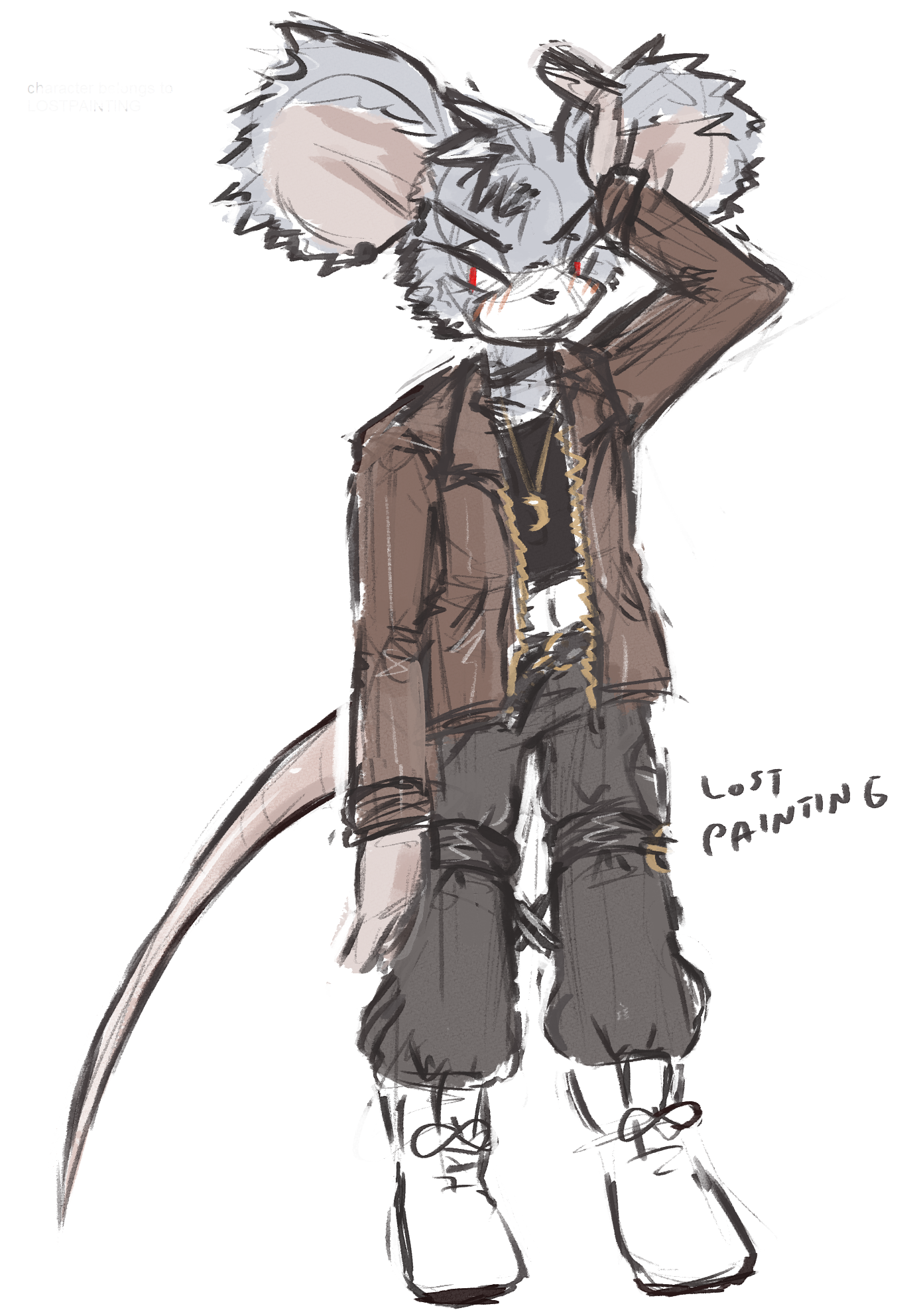so, how do i get into mechas, anyway?
mecha anime is something i always had a vague familiarity with, but never really knowing how to get into them, finding it rather intimidating. like, i probably ended up seeing every single scene and frame of neon genesis evangelion through gifsets plastered across social media sites, and i found myself watching fooly cooly seven times through my teenage years, but i never knew much outside of that. i knew of gundam from passing mention, but only knew just how long it was running, and probably assumed it was a singular series, thousand episode behemoth like one piece, and never looked into it further. then in my twenties, shortly after the start of lockdown, i first heard of eureka seven and found myself watching it on a whim. and i went, holy shit, i gotta see more mechas. fast forward nearly two years later since then, and i realize nearly everything i've watched since the pandemic started has been a mecha, with just a couple exceptions.
honestly, despite being into so many mechas, i wouldn't say i'm specifically watching them for the mechs. i don't entirely view mecha as a genre, and instead view them as a fascinating approach to worldbuilding that i've never really been able to find elsewhere. like, i feel i could say without a hint of irony that i am a wholehearted believer that nearly any series could be improved just inherently by having mechs. i just think it's so fascinating how they can inform a narrative through design and function, and how the cast interact with them and view them. in a way, i think it's really similar to including magic in a story, where i don't think you can't make clear assumptions about the tone or story of something just because it has magic, for example, the magic in any children's movie is going to be drastically different than what you'd encounter in any of kinoko nasu's body of works. i think the big o is a really good example of this, especially when contrasted to eureka seven's approach. in the big o, the mechs are lumbering titans, featuring large visible grates and pistons, yet they look almost art deco in their designs. which i think is really interesting with the jazzy, noir-inspired aesthetic the series has. in eureka seven, the mechs are very streamlined and limber, which ends up fitting the world of the series very well, which centers around a group of ex-military outlaws, featuring characters that feel very rooted in counterculture and 2000s streetwear. and what can these limber mechs be used for? surfing on the air.
so, how do you get into them? well, honestly, before i really knew how to look for stuff, i just found things by stumbling upon some account that overlayed music from various mecha over fitting images. however, i'm fully aware this method was completely deranged (unless you're someone like me, where that derangement was half the fun), so if you're looking for a jumping off point that's a bit more streamlined than mine was, i've outlined a few that i think are the best introductory material that give a wide range of what you can expect to find. once you have an idea of what exists, it's a lot easier to navigate finding things on your own. like how i started overman king gainer because i discovered i enjoy the art style and character designs of eureka seven.
the big O (studio sunrise, 1999. 25 episodes.)
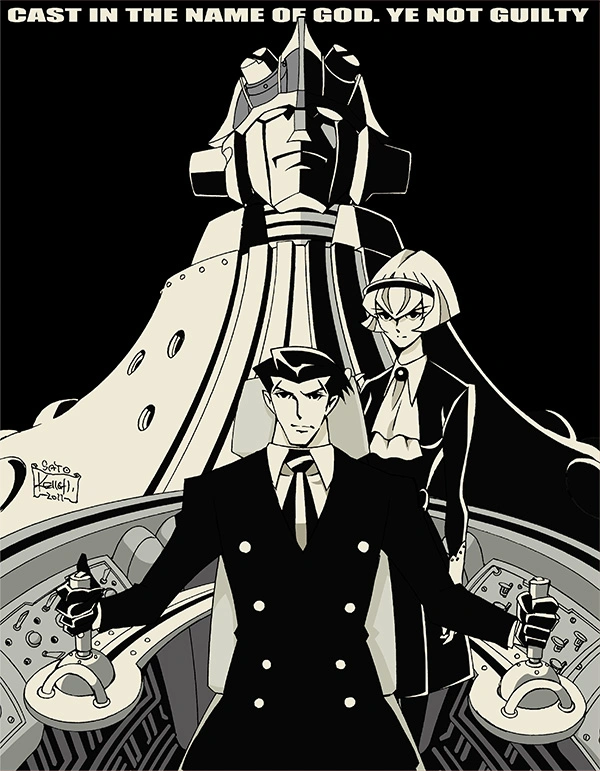
promotional artwork for the big O, featuring the two main characters - roger in the foreground, dorothy to the right - with the titular mech big O standing in the background. illustrated by keiichi sato.
interested in an anime where mecha meets noir in a series paying homage to batman, after the studio's work on batman: the animated series? maybe the big O by studio sunrise is for you. the big o follows ex-cop roger smith, also called roger the negotiator
the one major con i would give this series, is that i don't find the second season as much of a must-watch as the first. the latter half didn't end up feeling like it had quite the same charm, most find the ending to feel rather contrived - though i found myself enjoying it, and one episode in the latter half, "the greatest villain", i recommend skipping completely outright. like, i hate "the greatest villain" so much that i actually lied about the amount of episodes in the series, it's actually twenty-six episodes, not twenty-five. it's literally not worth watching and i wish i could get those twenty-odd minutes back in my lifespan, and this is coming from someone with a very high tolerance for filler. this singular episode infuriated me more than the ending, which is usually what frustrates people! however, i digress. i would still say it's worth watching the second season if you find yourself enjoying the first, since i find this series' premise and atmosphere really hard to find elsewhere, and it is just more the big o in the end. it provides closure to a fair amount of plot points the first season set up. i would just prepare for the ending leaving you with more questions than answers, which i was personally fine with.
if you like this series and want to see more like it, whether or not you actually enjoyed the second season, i highly recommend looking into its spiritual successor tiger&bunny, which ends up having a very similar approach and tone to this series, though it's less likely to be described as a "clusterfuck".
dai-guard (studio XEBEC, 1999. 26 episodes.)
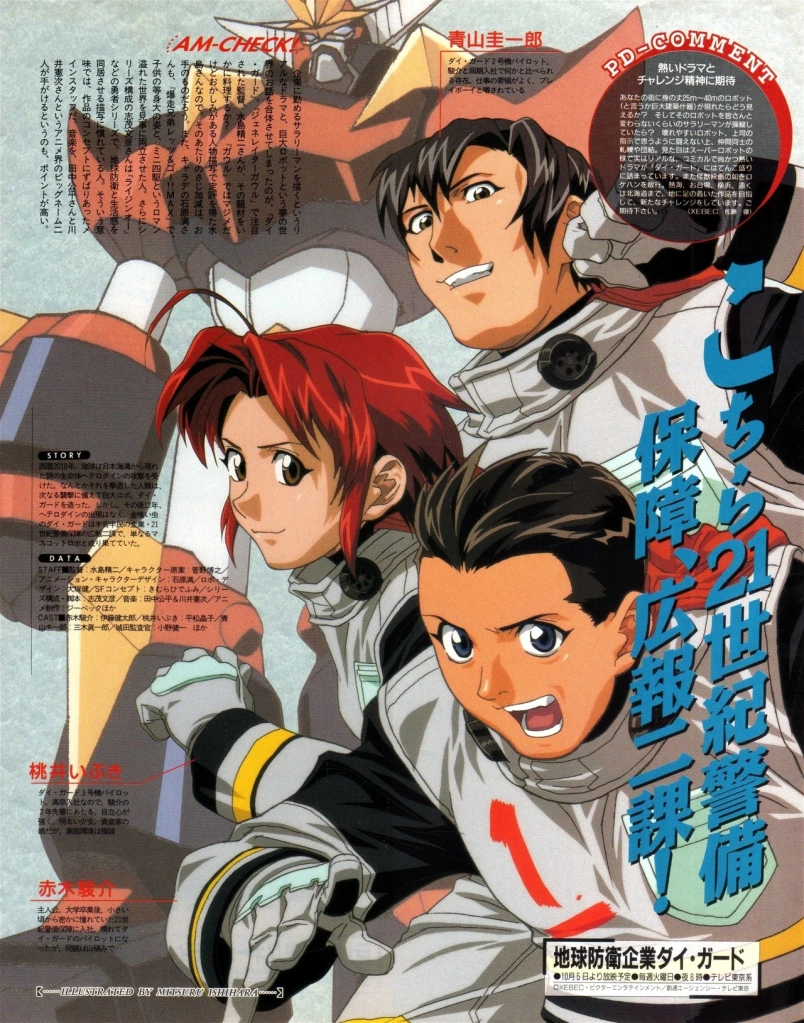
promotional artwork featuring the three main characters of dai-guard - akagi in the front, ibuki in the middle, and aoyama in the back - with the titular mech dai-guard standing in the background. illustrated by mitsuru ishihara.
dai-guard follows three office workers in their early- to mid-twenties, working in the PR division of the fictional company called 21st century defense security corporation - akagi shunsuke, momoi ibuki, and aoyama keiichiro. akagi being the pilot, ibuki being the navigator, and aoyama being the engineer. the appeal of this one i find very simple to summarize, and i think it would be an excellent introduction to mechas because of it - office workers saving the world. the characters really are just office workers, they don't have any special super powers, except the power of friendship and teamwork. it ends up being very easy to follow as a result. the premise is rather mundane, yet i never found it boring despite its mundanity.
the mech in this anime is initially just a large and clunky robot existing solely to drum up PR for the defense corporation. like, dai-guard itself already looks like a toy, you can tell it was built solely for this purpose. it wasn't built to be a top of the line mech, and it certainly wasn't built to save the world, despite being used this way. i find this to be really appealing, i think it adds a lot of realisticness to the series to have the mech be this clunky. like if we had giant mechs in real life, i do think they would feel a lot like this. due to its clunkiness, the dai-guard takes a lot of effort to pilot, and it requires the combined effort of three people all controlling and monitoring it to get it to perform. and it set the tone for the sense of groundedness this anime has in general, feeling grounded even when facing the threat of giant alien creatures, called heterodynes.
there's a sense of full responsibility with the mech and their actions while piloting it that i really respect, too. usually during stories involving superpowers or giant robots or anything else, there's generally a lot of wanton property damage that's cast to the wayside and never really acknowledged. however, in dai-guard, it's something that the characters actively have to take care of in between their duties of protecting the city - filing stacks of paperwork for damage reports, accident claims, insurance claims, and so forth for every destroyed car or building or damage to the mech. there was one instance i really enjoyed in particular near the beginning of the series, where akagi gets the idea to pick up a random car parked on the street with the dai-guard, and pelt it directly in the core of the heterodyne the team found themselves facing off against. this proved effective in being the finishing move for the battle, but akagi's battle truly wasn't finished, since he had to file an accident and insurance claim on the car he used as soon as he returned to the office.
i think there's genuinely only one major con i can give the series, and it's that the relationship between sumida and domeki is rather uncomfortable due to the age difference, and it leaves me wary of recommending the series to people without a heads up about it. however, the relationship isn't too in-your-face, with neither of them even going as far as holding hands, combined with the fact neither of them even really seem interested in each other, so i generally just found myself just trying to ignore it. it's a generally just weird and out of place thing to include in a series i would say is almost perfect otherwise.
∀ gundam (studio sunrise, 1999. 50 episodes.)
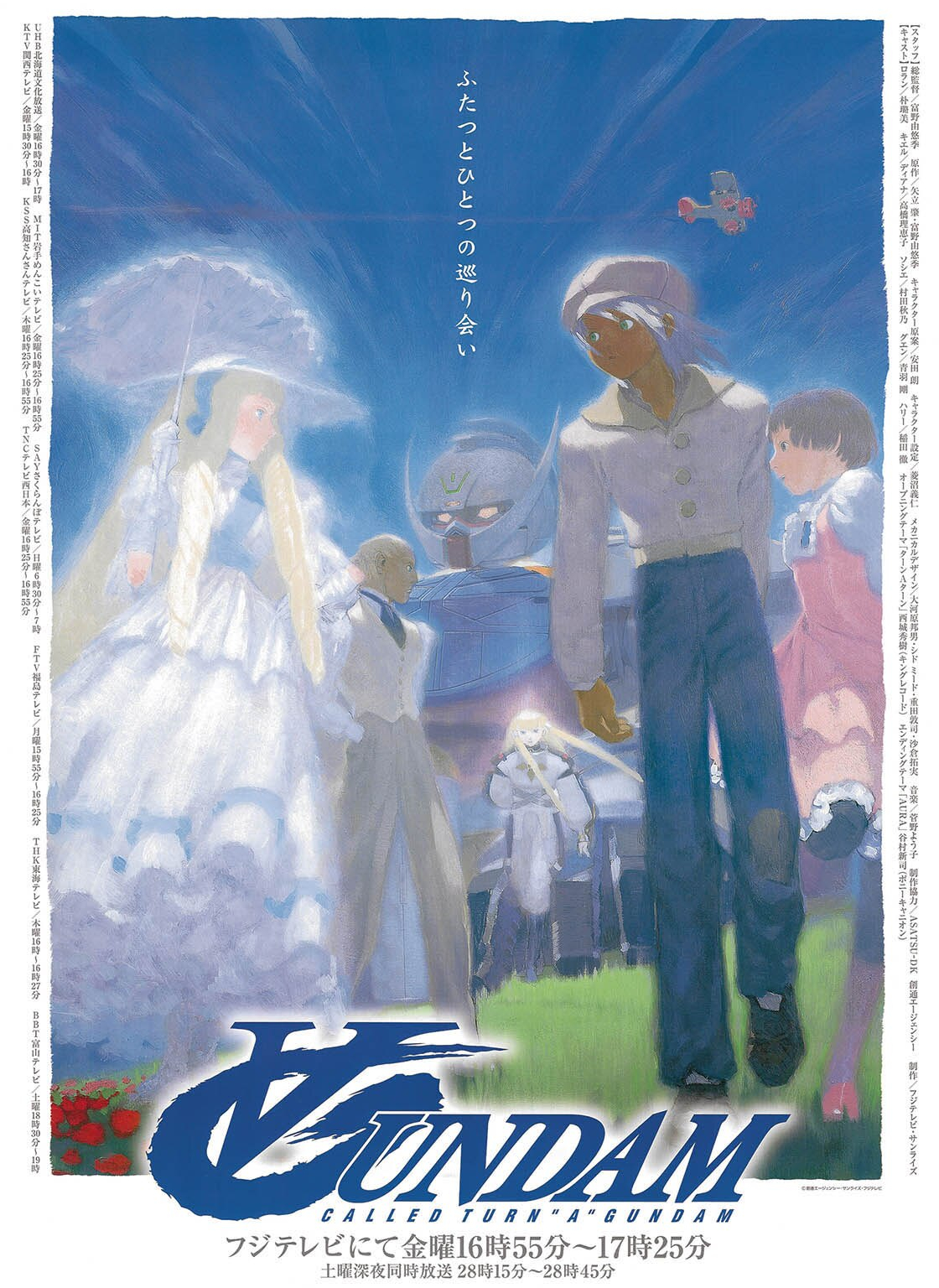 >
>
promotional artwork featuring five of the main characters of turn A gundam - loran in the foreground, with sochie behind him on the right, kihel and guin on the left, and dianna walking towards them in the back - with the mech the white doll standing in the background. illustrated by akira yasuda.
∀ gundam, also called turn A gundam is the story of an unusually futuristic mech unearthed in industrial revolution era america, the implications behind it and the impact this makes, and the pilot determined to use this mech solely to bring peace.
bark
eureka seven (studio bones, 2005. 50 episodes.)
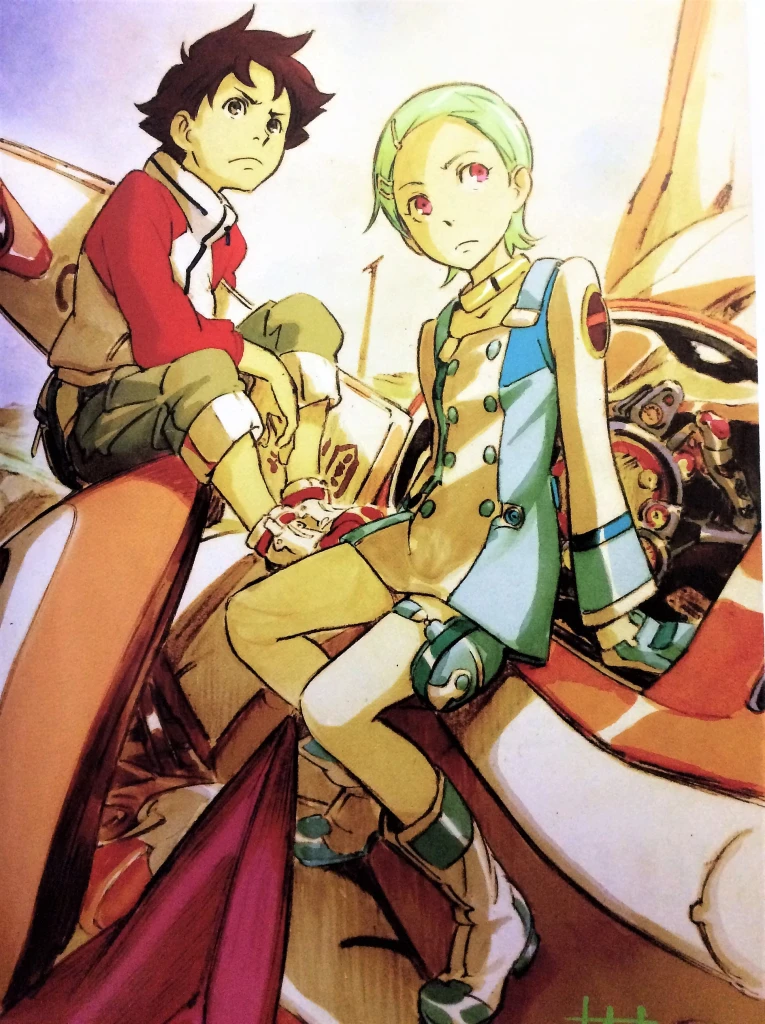
promotional artwork for eureka seven featuring two of the main characters - eureka on the right and renton on the left - sitting on the cockpit of the mech nirvash type ZERO. illustrated by kenichi yoshida.
saving this for last, because oh man, this is the one that really kicked it off for me. this one fucking fires on all cylinders, i consider it to be one of the pinnacles of media. like, i used to be a "who gives a shit if the curtains are blue" person, which may be embarassing to admit, but whatever. this singular anime changed that for me, now i look for symbolism in nearly every media i engage with. it's that fucking good. unfortunately, it may have rewired me too hard, as it's the anime that kickstarted in my brain "i cannot get into something if it doesn't feature a giant robot."
